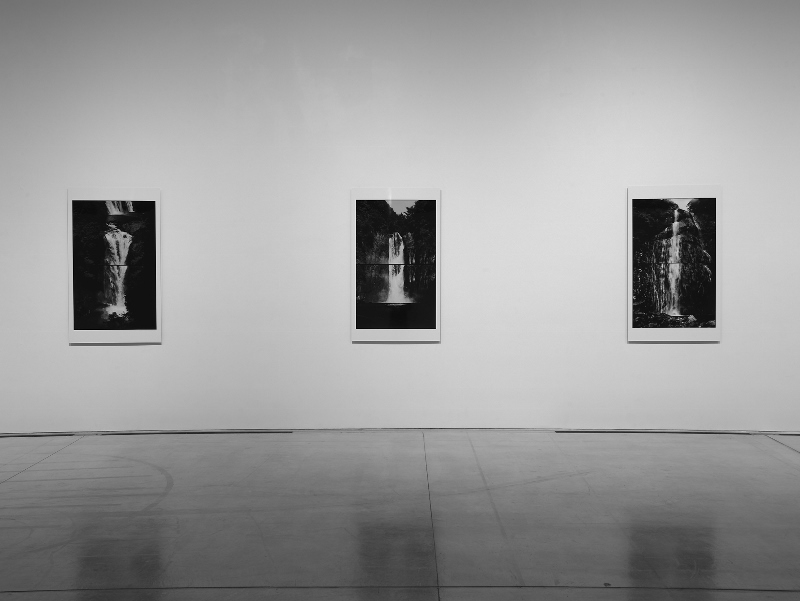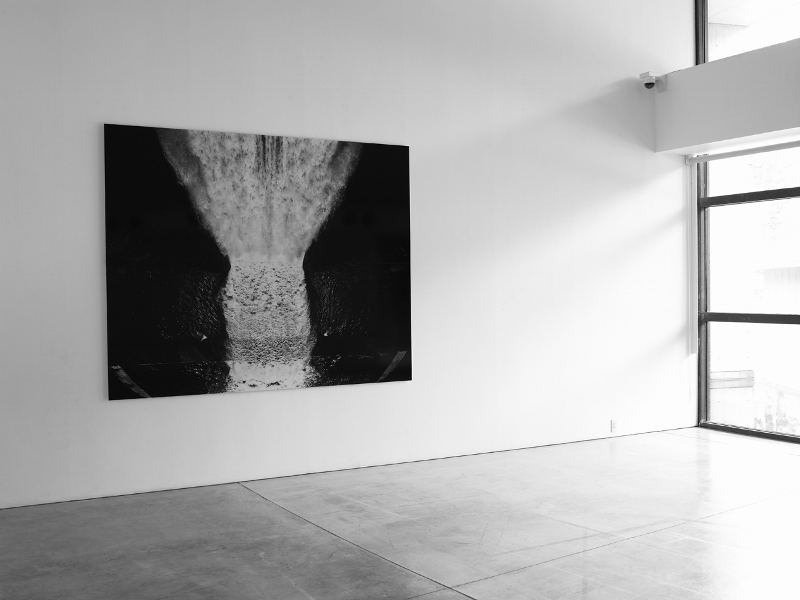
山本糾―落下する水
2010年4月24日 (土) ~6月13日 (日)
山本 糾
YAMAMOTO Tadasu
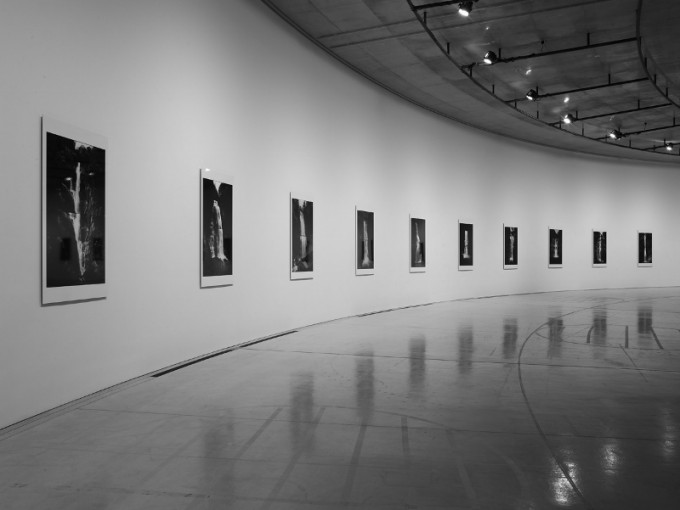
展覧会風景 撮影:山本糾
落下する水、光の柱――山本糾の写真について
近藤 由紀
山本糾の作品には常に水がある。言いかえればそれは光である。光を描こうとした印象派の画家たちが繰り返し水面や霧を描いていたように、光の存在は水によって知覚され、別な姿を借りながら、その不可視の姿を私たちの目前に現してきた。
物体に反射した光をレンズを通して感光剤面上に結像させ、現実の写像を得る写真にとって光はさらに特別な存在である。山本の処女作ともいえるシリーズ作品≪Bottles≫(fig. 1)は、この光を捉えること、写真というメディアを使うということに自覚的になった最初の作品であるという(1)。この薬瓶の選択には、山本の個人的な過去も反映されてはいるが、それ以上にそれはまさに写真機そのものの置き換えであり、被写体としての「対象」を捉えたというよりは、「写真」を対象化することを試みた作品であった。上部に水滴を貯め、少量の液体の入った薬瓶は、強い光をあてられて左下に濃い影を落としている。その影の中には光がガラスによって屈折し、焦点を結ぼうとしているのがみえる。すなわちそこにはガラス=レンズという意識が反映されており、写真で「写真」を撮影したメタ写真的な作品であるということができる。これ以降山本の作品では光を捉えるということが意識され、それゆえに光に敏感に反応する物質、すなわち水がさまざまな形で登場することとなった。≪落下する水≫のシリーズは、この作品を制作した後、1980年代後半から始められた継続的な作品のシリーズでもある。
≪落下する水≫は、文字通り落下する水、すなわち滝を撮影した白黒写真である。暗い背景から浮き上がるようにまっすぐと延びる滝は、暗闇に立ちあがる光の奔流のようにもみえる。長い露光は水を緻密に捉え、水というよりは無数の白い糸、白い粒のようにもみえ、闇に沈んだ木々や岩肌をうっすらと照らしている。この暗く切り立った岩場の中心に垂直に立ち上がる滝に対し、滝が落下する地点では水飛沫が作り出す柔らかい水平線が生まれている。さらに山本は、画面中央に写真の上下を分断する人工的な強い水平線を作り、画面に硬質な構造を与える。山本は、この力強く抑制的な構図を作り出すために、広角レンズを使わず、滝を上下に分けて撮影し、それをつなげている(2)。そうすることで滝の垂直性をより強め、さらに分断された画面により見る者の視線を上下に分けることで、映像フィルムの上と下を眺めるような時間的なズレをつくり、制止した奔流に別の時間を与えている。
≪落下する水≫に限らず山本の写真では、闇を押しのけて顕現したばかりの光がそこにとどめられているような心地がする。さらに場面を平板化させる強いコントラストが表面性を、画面の硬質な構造が静謐さを与えることによって、時間と空間が宙ぶらりのままとどめられているようにもみえる。このように山本の作品の風景は、そこが現実のどこかであるという生々しさや、その場所で写真が撮影された前後に何かが動いたり、何らかの音がしていたりといった現実感覚から分断されている。バルトは『明るい部屋』の中で、写真は過去志向であり、その時間の不動化には不思議な停滞と一時停止という観念そのものが含まれていると述べている(3)。現在とつながりを持たない絶対的な過去がそこにあり、それこそがこの世常ならざるものを示しうるのだと。山本の作品からは、過去や未来といった時間ばかりではなく、そこがどこであるかという空間すら着地点を持たず、一時停止したまま宙づりにされているような印象を受ける。
画家たちを現実の対象を描くという伝統から解放し、抽象へと向かわせた印象派の光は、それゆえに彼らにとって非物質的な存在であっただろう。一方で写真、すなわち光を集め、化学反応を起こさせ、像を焼きつけ、さらに薬剤によってその潜像を可視化させる写真を対象化しようとする山本にとっての光は、あくまで物質である(4)。それにより我々は目の前の現実の一瞬を一枚の写真として手に入れることができる。つまり光は物質として作用すると同時に、たとえ現実を基盤としていても頭の中にある、あるいは網膜が捉えた非物質的な「像(イメージ)」を写真として物質化する。山本が捉えた宇宙に遍在する光や絶えず形を変えとどまることのない水は、それ自体が超時間的、普遍的であるが、山本の写真から受ける宙づりされた感覚は、それが現実の対象でありながら、同時に現実を反射しただけの何物でもない光の表層として目の前に表されていることが意識されるからではないだろうか。
ところで≪落下する水≫の硬質な構図をつくる意識的な垂直と水平は、混沌とした自然に対峙するものとして与えられたものであるが、そこには撮影者が暗い山道を登り、開けた先に突然姿を現した滝を眼の前にしたときの圧倒的な感覚も加えられている。いうまでもなく滝は古くからさまざまな土地において信仰の対象とされてきた。突如として出現した自然のエネルギーの奔出に崇高さやアニミズム的な神性を感じることは、素朴な感応性であると同時に、人間の深い洞察力によるものだろう。山本の硬質な画面のなかに切り取られた滝は、荒々しさと静謐さ、永遠と一瞬を併せもつことで、神々しさを湛えた光の柱として写真に焼き付けられているかのようである。この構図的な秩序は、混沌の中にある「自然の滝」を、我々の祖先たちが「神」とみなし、その流れにさまざまな思想を投影させた「概念としての滝」へと転換させたその予兆を与える。それは現実を背景にした現実を否定することで出現したイメージである。こうして≪落下する水≫の滝は、古来より綿々とつながる滝に対する感受性が一種のイメージの投影として表され、その超時空性をより強めているのではないだろうか。
一方で≪落下する水≫を水平に分断する線は、そこに再び現実を呼び戻す。上下に合わせられている写真は、画面を完全に二分しているのではなく、若干(場合によってはかなりの分量で)画面が重ねられており、画面に映像フィルムの連続するコマをみるときのような時差を与える。この「映像化」により写真の静止した時間は少しだけ動きだし、見る者はそこに現実的な時間軸を重ねる。こうして眼前の落下している水は、名勝の滝として、一本の光の柱として、我々の頭の中にあるイメージの聖なる滝として目の前に現れる。それらの間を振り子のように揺れ動くことで、私たちは宙づりにされる。そしてそれこそが一方で写真なのであろう。こうして≪落下する滝≫は、写真とそのイメージについて再び語りだす。
(1)2008年11月14日、「nacaアート井戸端会議」での山本糾レクチャーでの発言。
(2)2010年4月24日、ACACでのアーティスト・トークでの発言。
(3)ロラン・バルト『明るい部屋 写真についての覚書』、花輪光訳、みすず書房、1985年、112頁。(Roland Barthes, La Chambre Claire. Note sure la photographie, Cahiers du Cinema, Gallimard, Le Seuil, 1980.)
(4)2010年11月13日、筆者による質問に対する山本の回答。
ギャラリーA 撮影:山本糾
ギャラリーB 撮影:山本糾

fig.1 《Bottles ブドウ糖注射液I》、ゼラチン・シルバープリント、1982年。
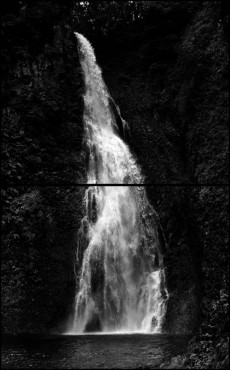
《落下する水―暗門一の滝》、ラムダ・プリント、172.0x101.6cm、1991年。
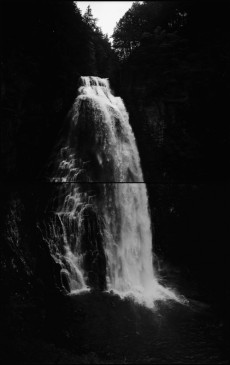
《落下する水―番所大滝》、ラムダ・プリント、172.0x101.6cm、2009年。
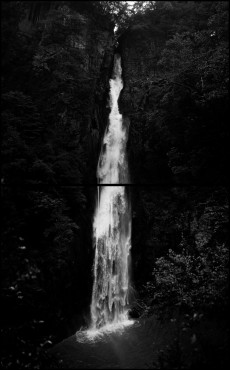
《落下する水―西椎屋の滝II》、ラムダ・プリント、172.0x101.6cm、2006年。
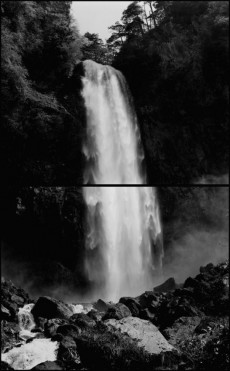
《落下する水―平湯大滝》、ラムダ・プリント、172.0x101.6cm、1991年。
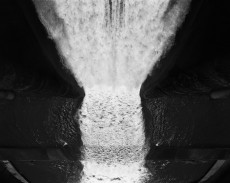
《落下する水―船津ダム》、インクジェット・プリント、200.0x250.0cm、2009年。
YAMAMOTO Tadasu―Falling Water
April 24 ~ June 13, 2010
YAMAMOTO Tadasu
山本 糾
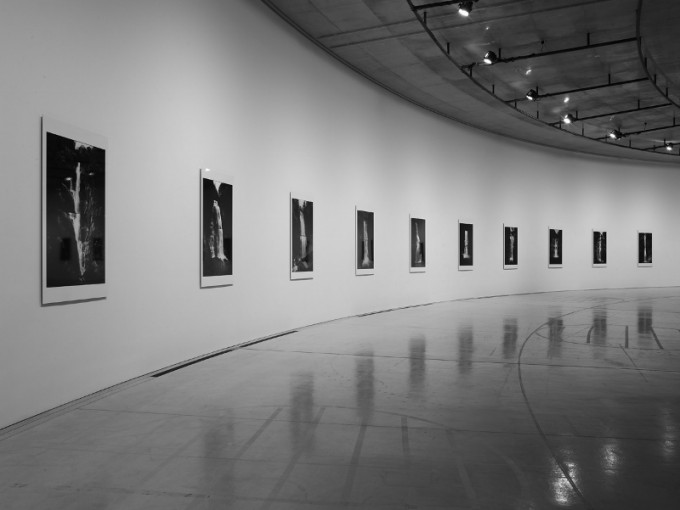
installation view, photo: YAMAMOTO Tadasu
Falling Water, Pillar of Light─on photos of YAMAMOTO Tadasu
KONDO Yuki
There is always water in YAMAMOTO Tadasu’s work, and in other words, it is light. As Impressionist artists painted repeatedly the surface of water and fog in order to express light, we perceive the existence of light through water, and light has presented itself before our eyes in different assumed forms.
In photography, light has a special meaning as light, reflected on an object, forms an image on a sensitizer through a lens to obtain a real representation. It is said that his series “Bottles” (fig. 1), Yamamoto’s maiden work, is his first work after he realized what it meant to use photography as a medium.(1) The fact that he chose medicine bottles reflects his personal past experience, but beyond that, it means rearrangement of a camera itself, and he tried to view photography objectively in this work, rather than simply capturing an object as the subject. A medicine bottle, which contains a small amount of liquid with some drops on the upper inner glass, is exposed to strong light and casts a dark shadow on the lower left side. In the shadow, you will see light refracted through glass and converging to focus. It means that the idea of glass=lens is reflected and the work is a kind of meta-photography in which “photos” taken with photos are produced. After this, Yamamoto has become conscious of catching light in his work. Consequently, water as a substance sensitively reacting to light began to appear in various ways. After having produced this piece, Yamamoto began creating series “Falling Water” on a continuous basis in the latter half of the 1980s.
“Falling Water” is literally a falling water, that is, black-and-white photos of waterfalls. The waterfall moving straight downwards appears to be rising from the dark background or to be a torrent of light rising in the dark. As a long exposure enables minute observations of water, it looks as if there were innumerable white threads or drops instead of water slightly lighting up trees and rock surfaces in the dark. In contrast to the waterfall standing up perpendicularly in the middle of the dark sheer rocky cliff, a calm horizontal line is formed with splashes at the spot where the waterfall falls. What is more, Yamamoto creates, in the center of the picture, a strong artificial horizontal line dividing the upper and lower parts of the photo, which gives the picture hardness in structure. In order to produce this powerful and restrained composition, he photographs, without using a wide-angle lens, the top and bottom parts of the waterfall separately and combines the two later.(2) In this way, he makes it possible to emphasize the vertical movement of the waterfall, and furthermore, by drawing viewers’ attention to both upper and lower parts of the picture, he succeeds in giving the static torrent a notion of time such as a time difference between the top and bottom of a moving picture.
In Yamamoto’s works, not limited to “Falling Water” alone, there seems to be newborn light that manifests itself pushing darkness aside. Additionally, strong contrast leveling out the scene gives the quality of surface while the hard composition of the picture gives tranquility so that time and space appear to be staying there hanging in midair. Thus, the scenery in his work is apart from our sense of reality; a vivid description of somewhere in reality and some movement or sound seen or heard before and after the moment the shutter release is pressed at a specific place. In “Camera Lucida,” Roland BARTHES said to the effect that photography is oriented to the past, and immobilization of time implies the very concept of mysterious stagnation and temporary lapse.(3) He means to say that there is the absolute past that is not connected to the present, and it is the very thing that suggests the world’s ever changing nature. Looking back at Yamamoto’s work, I get the impression that even the space axis showing “where” is hanging in the air, let alone the time axis of the past and future.
Light led Impressionist artists to abstraction freeing them from the convention that they should depict real objects, and light may have been the non-material thing to them. As for Yamamoto who tries to objectify photography, light is material to the last.(4) Collected light causes a chemical reaction to a sensitizer and prints an image to make the latent image visible. That is why we can obtain a photo representing a real moment before our eyes. In other words, light works as material, and at the same time, it materializes a non-material image reflected on the retina, which is in our mind even if it is based on reality, as a photograph. Yamamoto catches light unevenly distributed in the space as well as water that changes form constantly. Though each of the two is universal in itself transcending time, his work gives us a feeling of hanging in midair. It is probably because it is shown before our eyes as nothing but a surface layer of light merely reflecting reality while it is actually a real object.
Conscious usage of verticality and horizontality to create the hard composition of “Falling Water” is adopted to face nature in its chaotic state, and at the same time, an overwhelming sensation is also expressed, which a photographer experiences when, after climbing the dark mountain path, his view opens up to see a waterfall before his eyes. Needless to say, a waterfall has been the object of worship since ancient times at different places. It is our simple, natural response to feel sublimity and animistic divinity towards an outburst of natural energy that appears all of a sudden, and at the same time, it depends on our deep human insight. The waterfall cut out in Yamamoto’s hard picture appears to be a pillar of light endowed with sublimity printed on the photo, by containing both wildness and peace as well as eternity and an instant. The orderly composition gives us signs that “a natural waterfall” in the chaos was converted into “a waterfall as the concept” which our ancestors showed their respect to and various thoughts have been reflected on. It is an image created by denying reality in the background of the real world. In this meaning, I believe that the waterfall of “Falling Water” is an expression of an image reflecting our sensitivity towards the waterfall unbroken since ancient times, and it strengthens the quality going beyond space and time.
The horizontal line dividing “Falling Water” calls back reality there again. The photo, in which the upper and lower parts are combined, is not exactly divided into two. They overlap each other slightly (a fairly large amount in some cases), and there is time difference between the two as if you were looking at continuous frames of a picture film. Because of this effect of the moving film, the static time of the photo begins to move slightly, and viewers see it along the real time axis. Then the falling water before our eyes appears to be a natural spectacular view, a pillar of light, and a sacred waterfall in our imagination. Swinging like a pendulum between the two, we feel hanging in midair. That is what the photograph is in a sense. Now “Falling Water” resumes a talk about photography and image.
(1) From YAMAMOTO Tadasu’s lecture at “naca Art Idobatakaigi” forum, November 14, 2008.
(2) Yamamoto’s comment in his artist talk at ACAC, April 24, 2010.
(3) Roland BARTHES, La Chambre Claire. Note sure la photographie, Cahiers du Cinema, Gallimard, Le Seuil, 1980. Published as “Camera Lucida” in English.
(4) Yamamoto’s answer to the writer’s question, November 13, 2010.
Installation view, Gallery A. photo: YAMAMOTO Tadasu
Installation view, Gallery B. photo: YAMAMOTO Tadasu

fig.1 Bottles, glucose injection I, Gelatin silver print, 1982.

FALLING WATER―ANMON ITI NO TAKI, Lambda Print, 172.0x101.6cm, 1991.

FALLING WATER―BANSHO OTAKI, Lambda Print, 172.0x101.6cm, 2009.

FALLING WATER―NISHISHIIYA NO TAKI II, Lambda Print, 172.0x101.6cm, 2006.

FALLING WATER―HIRAYU OTAKI, Lambda Print, 172.0x101.6cm, 1991.
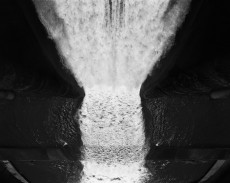
FALLING WATER―HUNATU DAM, Inkjet Print, 200.0x250.0cm, 2009.

